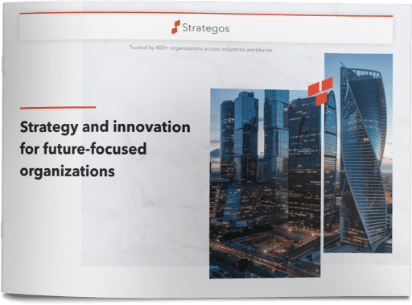
By Misook Lim – Head of Innovative Management Center at KT
For further reading: korea telecom case study written by Prof Julian Birkinshaw from London Business School
Summary
KT had so far sought innovation with a top-down approach, but a growing consensus was that it needed ‘employee-led Bottom-up innovation’ to become an innovation company with a sustainable growth. For this, KT developed IM(Innovative Management) Methodology and conducted training programs so that employees could identify, define and resolve problems themselves. At the same time, diverse projects and competitions were offered to execute what they have learned in the form of ‘learning by doing’, and, ideas that have been created through these courses were well nurtured by setting up ‘idea life-time management process’ to realize KT-specific innovation management. These ‘Bottom-up’ innovation activities definitely transformed KT’s corporate culture and infused innovation DNA, and the subsequent output resulting from these activities hopefully will bring about a great impact to external market, going beyond KT.
Context
- Privatization of KT
KT is the first and the largest telecom company in Korea. The company’s operation initially started in 1885, then known as Hanseong Telegraph Office. In 1980s, it first introduced fixed line telephones to households as a leader in the communication market, and in 1990s, it became a leader both in wired and wireless communication markets by introducing as many as 20 million lines in fixed telephones and mobile phone with PCS as well as high-speed internet ADSL, paving a way for KT to become a representative communication service provider of Korea. After its complete privatization in 2002, KT has led the informatization era by introducing high speed internet and 3G mobile communication service for the first time within the country.
- Crisis in Telecom Business
Even 10 years after its privatization, KT still had an excess number of staff, about 10 times more than its competitors, and lacked efficiency and lean management because of an obsolete corporate culture. In addition, its growth was impeded by reduced revenues from the fixed line telephone business which had formerly been a cash cow for the firm.
In the meantime, as the telecommunication market was rearranging itself with mobile communications at the center, newcomers including Apple and Google joined the market in addition to the traditional competitors, which intensified a sense of crisis among traditional market leaders.
- Success in Top Down Innovation and Sense of Crisis by Top Management
KT adopted sweeping innovation after a new CEO took position. It sought a synergy between KTF’s wireless business and KT’s fixed line business by merging the subsidiary of KTF (KT Freetel), and increasing awareness of the integrated KT both internally and externally by launching the olleh brand, which integrated KT and KTF. Olleh was highly acclaimed due to the ingenuity of reversing the word Hello along with using the sound of the well-known Spanish exclamation “Olé!” to convey a new management direction aimed at providing customers with continuous innovation and total satisfaction.
At the same time, KT was first to introduce the Apple iPhone in Korea and invigorated the domestic smart phone market, while other players in the market were lagging behind and arguing that the market was still immature. Despite the constraints from regulation and policy issues, KT took the initiative to change the business structure from the traditional voice communications business into a data/content providing structure that eventually came to lead the smart phone revolution, and provided a new paradigm for local IT manufacturers. However, KT’s top management, including the CEO, had different concerns.
Triggers
“A Sense of Urgency”
- Continuing Public Sector Mentality
As KT developed and grew, it still had to deal with the fact that large number of employees remained trapped in old mindsets. They had not yet let go of the company’s former hierarchical corporate culture and top-down mentality in which they simply did what they were told without passion or attention to the performance. If this attitude continues, it will undoubtedly be a knockout punch for KT from new contenders who are vying for their places in the ring. Top management saw a crisis coming and knew that KT would soon be doomed if the situation continued, forcing them to focus on transforming the corporate culture.
- Necessity of Bottom-Up Innovation for Sustainable Growth.
CEO Suk-chae Lee made a request to Strategos(an external consulting firm for innovation) to diagnose KT in an attempt to understand KT’s challenges in perspective. The consultants from Strategos identified innovation blocking barriers (5 major barriers: Unfocused activity, over-control, fragmentation, inconsistency, insularity) to KT after interviewing executives and employees and holding workshops. Once the company’s problems were clearly revealed, solutions were also easy to see. KT staff gradually built up their confidence for the telecom’s transformation. The first thing they did was to change KT’s passive corporate culture. When the organization allows employees to freely voice out their opinions and to bravely take challenges & risks, they will eventually nurture and secure competency(of identifying, seizing opportunities and executing) to flexibly respond to external changes, enabling them to find a breakthrough in the event that KT faces a crisis. That is what triggered top management including CEO to start Bottom-up Innovation.
Key Innovations & Timeline
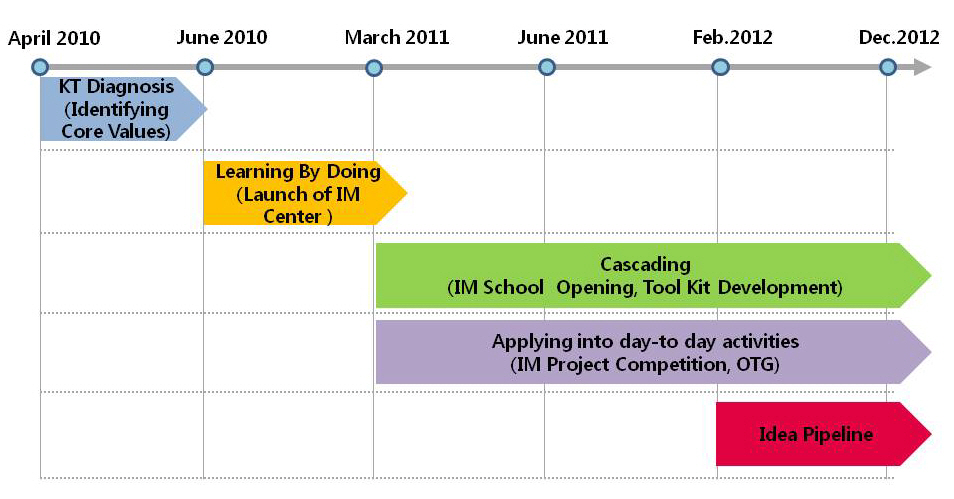
“Identifying 5 Core Values”
From April of 2010, KT staff and external consultants started KT’s innovation competency diagnosis for 10 weeks with a series of interviews with 40 executives, 15 seminars for employees, 6 workshops, and company-wide online survey(to 6,500 employees with 21% of response rate). This way, they could find 5 major barriers/issues that KT should overcome, which helped them finally to identify 5 core values to resolve those barriers against innovation.
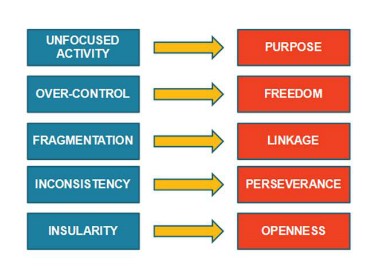
“Learning by Doing: IM Methodology Introduction and Utilization”
To realize identified core values, KT introduced an innovative management methodology and set up Innovative Management Center (IMC). The center was composed of 30 members who primarily came from KT internal organizations, and were carefully selected based on consulting competency as well as innovation competency. In addition, the center tried to seek a balance in its members with a combination of new, young employees (less than 3 years of experience in the company) with a less fixed perception, and external innovation specialists.
IMC executed the new business development projects by leveraging the IM Methodology(looking for insights by using diverse perspectives, and tools, & identifying various ideas through ideation, and setting up action plans by seizing innovation opportunities in new businesses as well as in existing businesses), resulting in five new business areas including IT Embedded Asset Sharing, and immediately went into action. It used IM Methodology for the first time at KT through a Learning by Doing course, customizing and institutionalized it into the company structure after seeing the results.
“Cascade by Training the IM Skills of Every Individual” (IM School)
IMC took the initiative to spread it through training programs across the entire organization after mastering the IM Methodology during the course of identifying new businesses. In the past, the employees had been simply pushed for innovation, but never received any practical training in innovation, which would have helped them work better. Thus, when they were asked if any of them had taken any practical lesson on how to carry out innovation in the same way they had taken lessons over and over again for playing golf, most of them could not answer “yes”.
The training program was first offered to leaders, because it was critical to change their thinking about innovation to help spread IM practices. For this, an executive leadership workshop on IM competency building was arranged for each team leader and member of their staff, while innovative management training was also arranged for new hires to infuse innovative management DNA into them.
Employees who had learned the innovative management techniques through training and task execution were trained to become innovation experts to help lead the innovation process in each area of the company. These newly-trained experts include an i-Consultant, a project leader in charge of full-scale innovative management projects by leveraging all the modules of innovative management methodology, and an i-Mentor, who can conduct smaller scale projects using those methodologies. These expert programs have a range of levels based on competency (Green Belt, Brown Belt, Black Belt) to set up competency enhancement target, and there were follow-up competency enhancement programs at each level on a continuous basis.
One thing to note in this process was that those employees who participated in the training programs voluntarily became leading entities in innovation and provided positive feedbacks on the ways to identify and resolve problems.
“I was extremely excited at the ideation process. I really want to apply this methodology into my day-to-day work.” -Hyunjoong Kim in KT
“I came to learn this methodology by doing it myself, which gave me expectation and confidence that I could work differently from this time on.” –Donghoon Kim in KT
“Application of Methodology into Day to Day Activities”
There is a saying: “To Know, and not to Do, is not to Know.” The best way to learn a methodology is to actually apply it — use it in real-life problem solving. While IM methodology training is being integrated into a company to allow for customer insight-based idea creation to help solve problems and the management has been fine-tuned, employees need to also be given a chance to apply the methodology into their problem solving in the day to day work environment.
- Innovative Management Project
They first conducted a project to use IM methodology on business issues which they had been struggling with. The Innovative Management Project proceeded in a diverse way depending on the business issue, ranging from new business development to unit service improvement. The objective was not just to solve problems but to build innovative management expertise by all team members. IMC provided relevant innovation experts with methodology “toolkits” to improve the confidence of the team executing a task and to enhance competency of every team member.
Employees who engaged in the projects expressed keen excitements at innovation possibilities by means of IM methodology.
“The previous innovation programs were admittedly somewhat forcible, but now I see I can really enjoy the innovation activities this way.” –Taemyung Ha in KT
“I have actually experienced the process of listening to customers on site, and now I am gaining confidence that I can execute innovation myself on site as long as a proper methodology is given to me.” –Jinhan Lee in KT
- Vice President OTG (On the Ground) Program
To transform employees, the changes in the vice presidents who lead them were a prerequisite, and for this, intensive systematic training was offered to them. In particular, VPs need to realize that they are innovation leaders themselves and develop competency required to induce employees to participate in the innovation as they need to urge employees to change, and also maintain the transformed system. For this, IMC developed 5 leader competency models to provide innovation leadership training for VPS.
1. Crafting an Innovation Strategy
– The ability to integrate innovation into the business strategy by: Laying the foundation, Assembling the strategy
2. Fostering Innovation
– The ability to let ideas emerge, develop & interact with other ideas by:Stimulating breakthroughs, Supporting Experimentation
3. Creating an Open Culture that Welcomes Innovation
– The ability to inspire employees to contribute their ideas by:Enhancing transparency, Broadening Involvement, Building Trust & Authenticity
4. Using Innovation to Amaze Customers
– The ability to drive innovation from the customer into the business by:Building the right attitudes, Getting the right information
5. Cascading Innovation throughout the Organization
– The ability to champion innovation at all levels by: Embedding innovation capability in the team, Aligning Systems & acting
Those vice presidents who completed the innovative management training shared what they had learned with other team members so that they could arrange workshops to resolve challenges that each team was facing. These training sessions were labeled the OTG (On the Ground) program with more than 120 VPs participating. Action plans made by these VPs and team members are currently in progress.
VPs and employees who participated in the OTG programs were immensely excited at mutual understanding, and gave positive feedbacks that they were confident of solving problems on site with IM methodology.
“It was new but very useful experience as I could look into problems and improvement opportunities in my work under the coaching of VP who already had completed the training program.” Sungwoo Choi in KT
“My boss(VP) has changed completely after attending the training. Now he is more attentive to our opinions and highly supportive to us than before. He used to have “Top-down mentality’ before.” Mihee Yu in KT.
- Innovative Management Idea Competition
KT organizes two versions of competition in each year. The first one is ‘Idea Competition’ in the first half of the year where employees make proposals on existing BM improvement or new business, while the other one in the second half is ‘Big Question’ where business issues in each business unit can be resolved by leveraging entire group intelligence. Innovative Management Idea Competition entitled “Counter-Attack on Ideas Kept in the Drawer” received 3,421 ideas for a two-week period where those ideas were filtered at each screening stage.
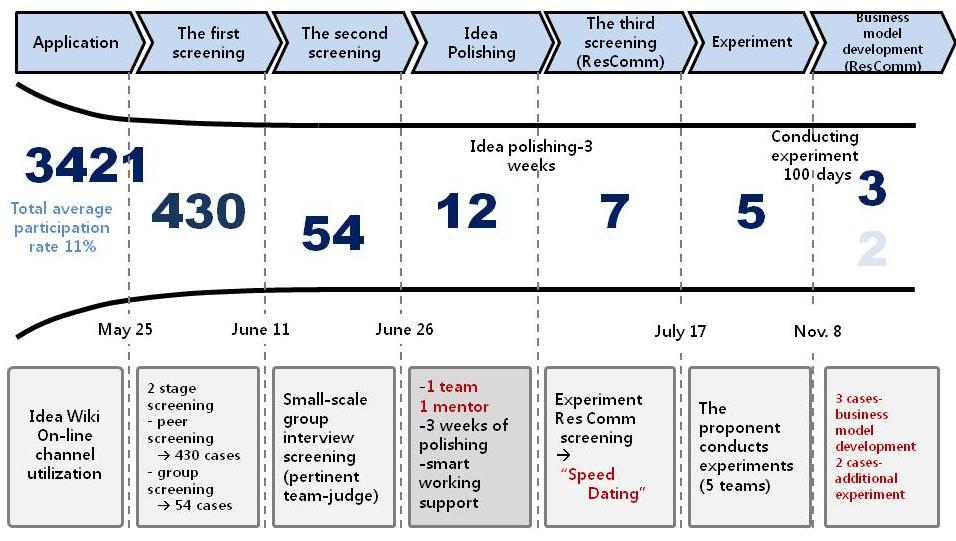
The differentiation in this competition was the participation of diverse employees in screening process. For example, the third screening in Resolution Committee invited employees whose period of service is 1-7 years, team head and executives so that each of them could conduct the screening in the form of speed dating(for higher transparency-not an one-way screening by the judge where the one who proposed the idea has small discussion with judges to explain the ideas) which had never been tried by KT before. This screening method holds a great significance in that the decision-making right, which used to be exclusive only to executives, is now granted to employees.
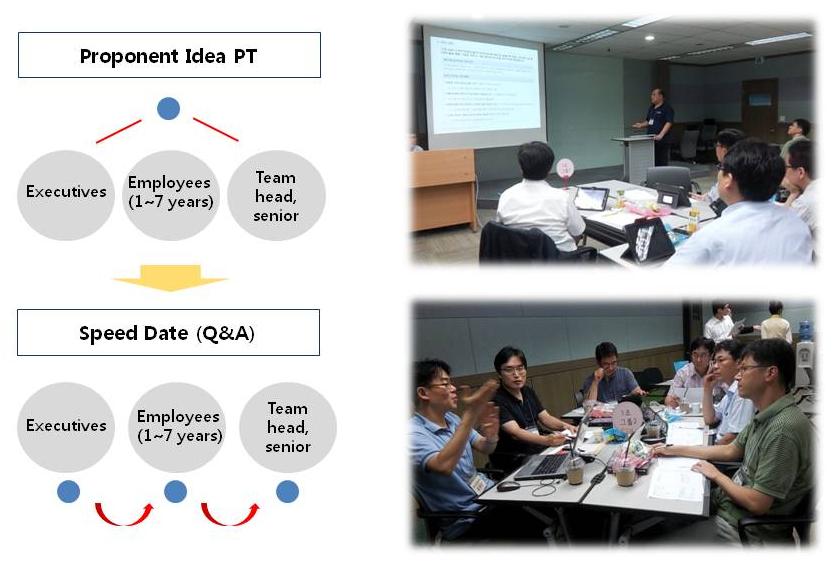
The strongest feature of the competition was a heated reaction since it so distinctively different from other earlier events of its kind. This competition allowed the employee who first proposed the idea to experiment and engage with it until the final business realization stage. The first competition, which took about six months from proposal to final business realization decision-making, reaped significant results with the final five ideas being realized into real business initiatives.
The second competition, labeled the Big Question(BQ), selected eight issues that business divisions have been struggling with were selected, and received ideas from all the employees for three weeks.
BQ 8 Issues proposed:
– Virtual Goods Service
– Mobile Payment Promotion
– All-IP No.1 Strategy
– Big Data Utilization Business Opportunity
– Wifi VOC Reducing ways
– Expanding penetration of Kibot 2(robot for kids)
– Open-type contents agency market
-Olleh player(Nscreen integrated media service) sales increase method
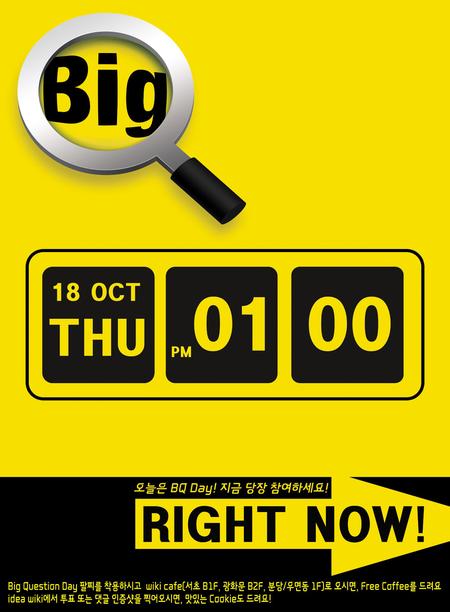
Afterwards, a Big Question Day when the management team as well as employees participated in the development process for each idea in a half-day session, finally voting for the best solution, came up with a final list of eight ideas. This second method, completely different from the previous approach, resulted in much positive feedback. KT staff perceived the process as something meaningful, not just more work but a fun, festive event that they could enjoy.
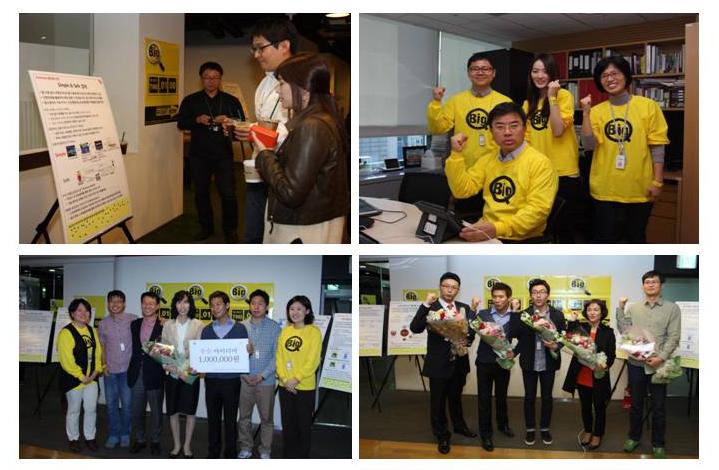
- Production of KT-specific Methodology Toolkit
A necessity of fine-tuning IM Methodology into KT was felt in the course of cascading due to its original nature of Western approach, which leaves some gap for Asian companies including KT to easily adapt it. A shift to IM Methodology with a qualitative approach from the previous quantitative approach based on fact & data for cost-reduction and business operation innovation was thus far more challenging to most KT employees because the new methodology was based on future-oriented, customer-insight mentality as well as on employee engagement for competency building.
This eventually required detailed guide in each template for better utilization and easier understanding as well as customization of case studies to make them relevant to KT organization.
In the meantime, IMC also found several problems in the methodology during the course of conducting a number of projects and tasks, and saw the necessity of summarizing accumulated experiences and know-how to keep them as asset, which made Methodology Planning Team of IMC initiate the customization. The team first conducted simulation of all the IM toolkit programs in an objective angle to evolve them into more relevant and viable ones, which finally gave a birth to a final customized toolkit version 1.0 for KT.
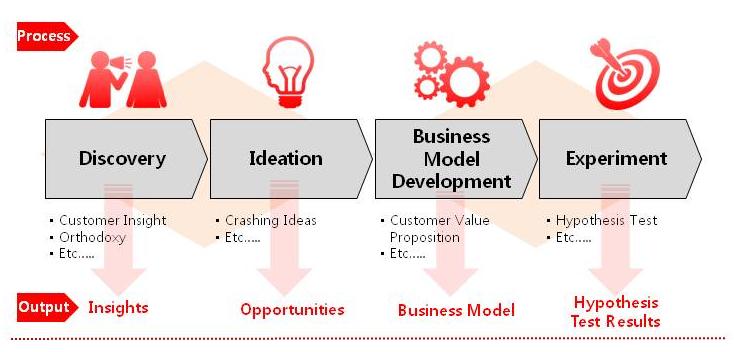
– Discovery: understanding customers and market by analyzing of unmet needs of customers, fixed perception of the industry, competitors and trend to identify insight and explore new business opportunities
– Ideation: Combining and colliding insights which were collected during Discovery phase to generate ideas
– Business Model Development: Specifying each ideas in detail to determine which value should be delivered in what way to which customers and how to generate profits
– Experiment: Setting up a hypothesis for success and validate it through small scale experiments to prove solid value of BM
“Constructing Idea Pipeline”
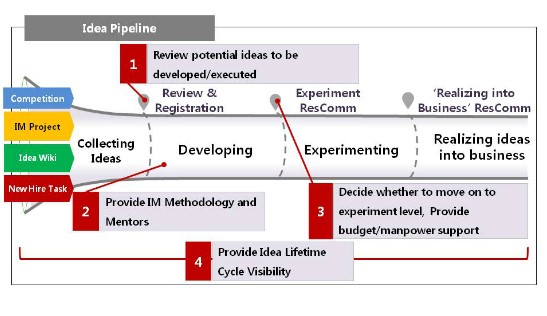
A number of ideas were identified across the company through a series of competition. However, a key element was finding ways to lead those ideas to final outcomes after execution, because past experience showed that good ideas meant little without solid support. To help solve this problem, the IMC constructed an “Idea Pipeline” to track and monitor the entire process as ideas were being created and developed. Once the ideas came into the pipeline get appropriate supports(human resources, methodology coaching, budget) according to situations of each stage(collecting, developing, experimenting and realizing into business).These ideas will be subject to continuous review(evaluation) and gradually develop to be matured.
Before going into the pipeline, each idea should pass screening processes by each channel. In case of competitions, final selection is made after the third screening stages, while in case of projects, final selection is made based on ideas generated from the project execution. On top of that, Idea Wiki was also mobilized, which is an on-line idea proposal platform where employees can freely upload their ideas anytime. Ideas introduced at Wiki are sorted by nature, and screened by each pertinent team member. For final decision for potential business model development of those nurtured ideas in the pipeline, i-Board(Innovation Board) was set up. It is a Resolution Committee where top management team participate.The Idea Pipeline proved to be beneficial to the growth of those ideas and for continuous tracking by top management so that execution of ideas as well as the effects of innovative management could be clearly observed.
Challenges & Solutions
“Innovation Fatigue”
- Challenge:
Frequent changes of CEOs at KT created a perception by management and employees that innovation always tended to be short-lived, from a maximum of 1 to 2 years. This was because every time a new CEO took office, innovation programs started from scratch and ignored previous programs as well as their accumulated know-how. In addition, most of the previous programs focused on efficiencies in terms of cutting costs, personnel resources and time (Six sigma, Human error zero, Customer value innovation program). These programs had faced strong resistance from employees.
- Solutions:
1. The CEO emphasized repeatedly that innovative management will remain unchanged in the KT system despite any changes in CEO because the current program is to change KT’s internal structure (DNA). This change will help remove doubts about perceived short-term thinking.
2. The literal translation of the word Innovation in Korean is “renewing the skin,” which connotes that innovation is as difficult as removing the skin from a body. For this reason, the wording was changed to “creative(創意) management(經營).” The new phrasing was used to remove the painful and difficult image and help minimize resistance by employees.
3. Communication activities were carried out to convey the message that innovative management does not bring about more workload, but more benefits to employees since they can directly participate and make changes in business tasks.
“Anti innovative Beliefs”
- Challenge:
A deeply bureaucratic and public corporation mentality has taken root within KT’s organization in the past. Anti-innovation beliefs including a number of practices, systems and cultures should be removed to help adopt innovative management as a company-wide culture. The following challenges were identified as issues that needed to be resolved.
– Customer satisfaction is only for the Customer Satisfaction Team
– Even with my contribution to the outcome, the outcome does not return to me
– No issue can be raised against opinions of the boss
– The existing way is the most comfortable to me
– I don’t need to be responsible for solving the problem even if I know about the problem
– I don’t see any immediate effect from leaving a problem, so it’s okay to handle it later if I don’t know what to do about it
- Solutions:
A full scale innovation campaign was launched to eliminate anti-innovative beliefs.
1. It is extremely important to let employees know that anti-innovative beliefs exist at KT. Campaign posters as well as videos against anti-innovation thinking were made and shown to all employees. Online and offline events based on the concept “Garden of Thoughts” were carried out to make employees think about issues related to anti-innovation. Online discussion rooms and bulletin board “trees” in public areas at KT were set up for people to talk and write down freely anything (using leaf-shaped post it notes) that comes up to their mind.
2. The challenges of anti-innovative thinking were linked to ACTION (All for customer, Collaboration, Trust, Innovation, Ownership, Now), the core value of the organization to provide an easy explanation to employees.
3. Intensive workshops and training programs were offered to VPs, whose influence is greater on employees, so that they could take the lead in changing anti innovation beliefs and behaviors.
“Quick Fix — Result!”
- Challenge:
The biggest barrier in the course of the IM program was pressure coming from impatience by employees as well as by top management who want to see immediate tangible outcomes. They believe that once innovation starts, the result should follow soon after.
- Solutions:
1. It takes Time. KT’s CEO communicated the message that KT’s DNA should be changed even though it may take a long time. He argued that the current innovation program is quite different from previous ones which required immediate, tangible outcome.
2. The entire process carried out in Idea Pipeline was reported visibly to provide continuous communication with top management. (i-Board, Idea pipeline Monthly letter etc)
“Good Ideas are not Enough.”
- Challenge:
Numerous ideas were chosen through competitions, projects and new hire training sessions, and the most viable ideas selected were transferred to related teams. However, sometimes ideas fail to develop in the right way, or are discarded midway through their development due to:
– Unclear decision-making (lack of accountability)
– No budget support
– Lack of compensation and evaluation systems
- Solutions:
1. Understanding the significance of ideas and execution by top management is the key to success. To promote this understanding, a Resolution Committee was established as a decision-making body for top management to decide whether to execute or support the ideas, and the i-Board was operated on a regular basis to review current issues and support. Participation of top management can provide clear rationale and accountability to relevant teams which execute the ideas as well as to the IMC.
2. An innovation budget (i-Fund) of 500 million KRW was secured to provide a separate budget to those teams which execute ideas so that they feel less burden in exercising budgets needed for execution.
3. Appropriate manpower support as well as related performance evaluation systems was made for executing innovation ideas. Sometimes, idea execution has been perceived as additional workload because compensation for execution has not been clearly stated. To help resolve this, the Resolution Committee and I-board were used to clarify compensation and support systems. (ex. Competition, Experiment Manpower Support, Upgrading the level in performance rating to any employee who makes a proposal on an idea which can be realized into business. (ex. Competency Rating: A, Performance Rating: one level upgrading)
Benefits & Metrics
“Applying Customer Centered Mentality into Day to Day Activities”
The most distinctive change of all since the introduction of IM is that employees are naturally getting accustomed to asking and discussing such questions as “What is it that my customers want?”(Customer Insight) and “What are fixed perceptions that we have?”(Orthodoxy) when they work for problem solving or task execution. This change led to new process for product launch (PLM 2.0, Product Lifecycle Management) which puts ‘Customer Needs’ first from the development stage based on IM Methodology.
– 2011: 6,710 employees completed the innovative management methodology course
– 2012: 3,516 employees completed the innovative management school
“Small Ideas Become Big Ideas”
- KT New Business Identification: Two of five ideas are currently being realized into business.
– Drive plus (Car Sharing Service): Pilot service is under way in collaboration with Suwon City
– Tostage.com (Artist Resource Platform Service): Currently under way as in-house venture format
. Achievements: 7 projects (6 projects excluding Rock Band ‘Sinawi’: Vocal Audition),
CSR project ( Artist Talent Donation to local schools in Mongolia, Rainbow School)
- Projects: Total 45 cases from the second half of 2010 to the second half of 2012
Expected financial outcome: Approximately 16.7 billion KRW
– 2010: Ansimi (Safety) service improvement and 2 other projects
– 2011: New sales channel exploration via on line channel for iPad sales and 8 other projects
– 2012: OllehTV T-commerce activation project, customer analysis and product development for differentiation of music products and 31 other projects
- Competition Idea
– Five ideas from the first competition are being realized into business
– Expected financial outcome: approximately 3.3 billion KRW
. Biz Messaging Plus: Messaging business for corporate customers
. Mplow: Music/songs creation solution & music/song distribution platform business
. Premium child-care business, child-care business leveraging KT asset
. OTV real-time TV rating business: IPTV rating survey business
. NFC Tag Connect U: NFC platform building project
– Two ideas from the second competition (Big Question) are being realized into business
. WiFi VOC Zero: WiFi service improvement idea
. Touch & Buy: Virtual goods distribution platform project
“i-Consultant, i-Mentor Development”
– Those who attended training sessions and project execution naturally developed competency for leading and coaching innovative management to become project leaders (i-Consultant:64), and project supporters (i-Mentor:468)
– Fostering innovation experts contributed to cost saving of 29.8 billion KRW per year
(i-Consultant: 6.4 billion KRW, i-Mentor :23.4 billion KRW)
“Changes in Perception of KT from Outside”
- Won the Grand Prize of Korea GPTW (Great Place to Work)
- Won 2012 Corporate Innovation Grand Prize
This Bottom-up Innovation eventually reinforced the innovation image of KT. In 2012, KT was rated as the No. 6 company they want to work for by university students. At the same time, the outcome of the quiet innovation within the company was gradually revealed to the outside. KT was getting rid of its old, outdated image. It won the Grand Prize of Global GPTW in 2012, which was given to a company where employees are the priority in the workplace. It also was the winner of the Presidential Award, the 19th Corporate Innovation Grand Prize with recognition of its management innovation.
Thanks to these innovation efforts, KT built up Innovation Competency in three major pillars of People, Creative& Customer Centric Idea and System. The previous two years- 2010 and 2011- were the beginning stages of introducing and building up IM into KT, while this year-2012- saw the outcome generating stage after the penetration of IM methodology into each unit of KT. The next two years -2013 and 2014-are expected to be the impact spreading stage where the outcome of Bottom-Up Innovation expands out from KT and triggers a major impact to affect the entire market.
Lessons
1. Leadership by the top management is the key. Without full engagement in decision-making and authorization, employees cannot be sufficiently motivated.
2. To push forward with persistence without stopping is important. Barriers are found at every stage of innovation. Firm determination is desperately needed to move on as the resistance level gets higher.
3. Institutionalizing IM into day-to-day activities by way of Learning by Doing is extremely important. The best way to do this is to encourage employees to use the methodology as a problem solving tool, and practice it repeatedly.
4. Generating lots of ideas or new ideas may be meaningful, but unless they are executed, there is little point in creating them. For following through on ideas, a solid management process is needed to support execution.
5. To change the company’s internal thinking or DNA, training and engagement are both prerequisites. After these elements are secured, a system should be provided to help innovative ideas could flow in a clear and transparent process.
6. Innovation stories should be shared. (whether they are about success or failure)
– Failure also is an asset. In an environment where failure is accepted, employees change their attitude toward challenges, and become more proactive rather than passive toward their tasks. Creating an experimental environment within the organization is also important.
– Through the validating process of experiment, even employees witness that the opportunity is either too weak or none and finally fail to turn those ideas into business, as long as they understand implications, the experience itself is said to be a part of success.
– It’s important to visualize the innovation outcomes (success stories), because they serve as a foundation to continue innovation and work as a positive energy for innovation activities.
7. To lead Bottom-up Innovation and employee-led innovation, a natural change should be made in the day-to-day activities of the employees. This cannot be done simply through training programs. Innovation must become a way of life, not simply a short-term training program.
Credits
- Suk-Chae Lee, CEO, KT
- Yung Kim, Senior EVP, Head of Corporate Center
- Hong Jin Kim, President of Global & Enterprise Business Group
- Jung Hee Song, Senior EVP, Head of Service Innovation Group
- Pill-Jai Lee, Senior VP, Head of Business Transformation Office
- GS Lee and Misook Lim, leaders, IM Center (IMC)
- Divisional IM team members
- IMC team leads and members
- i-Consultants and i-Mentors



